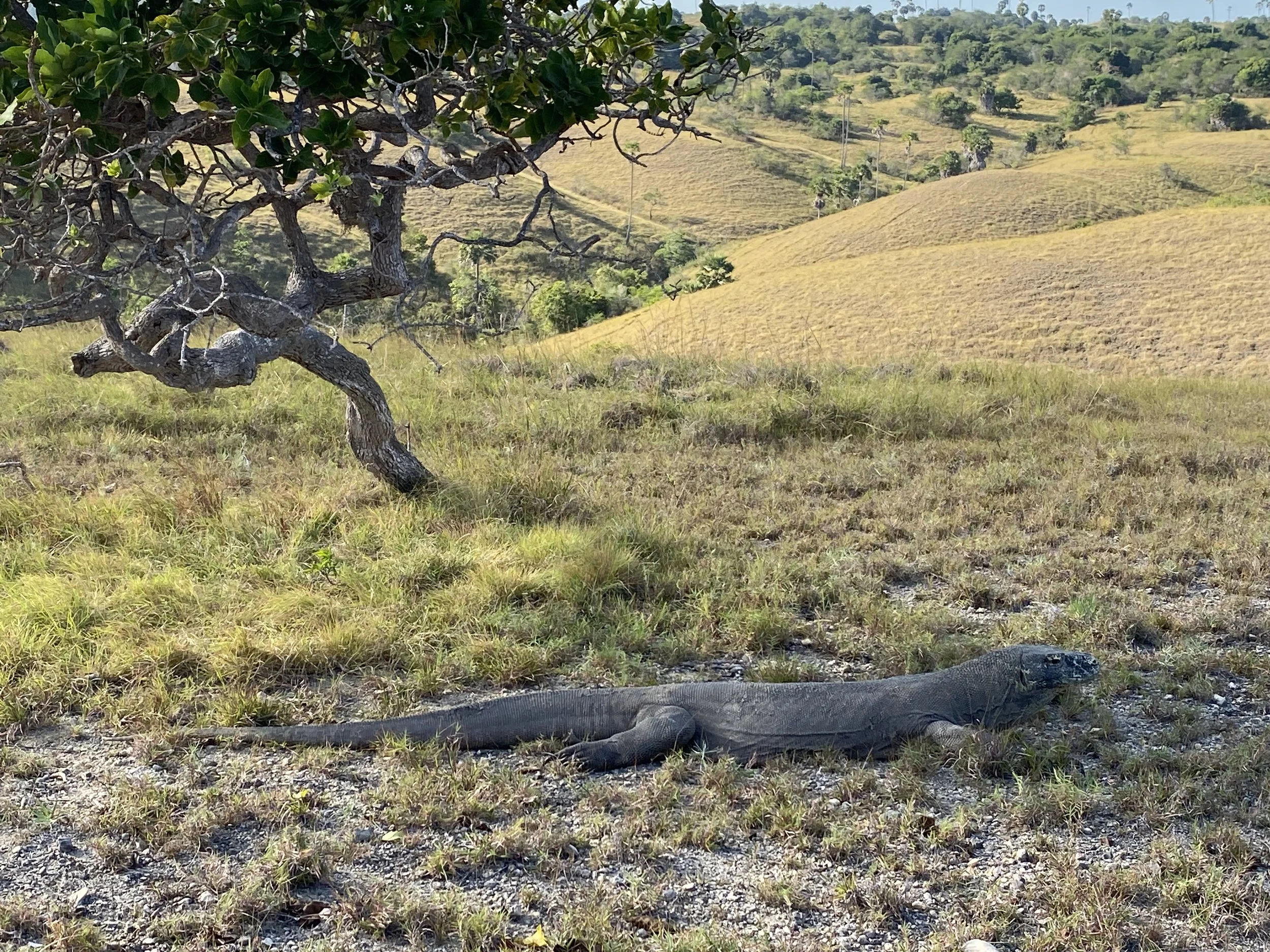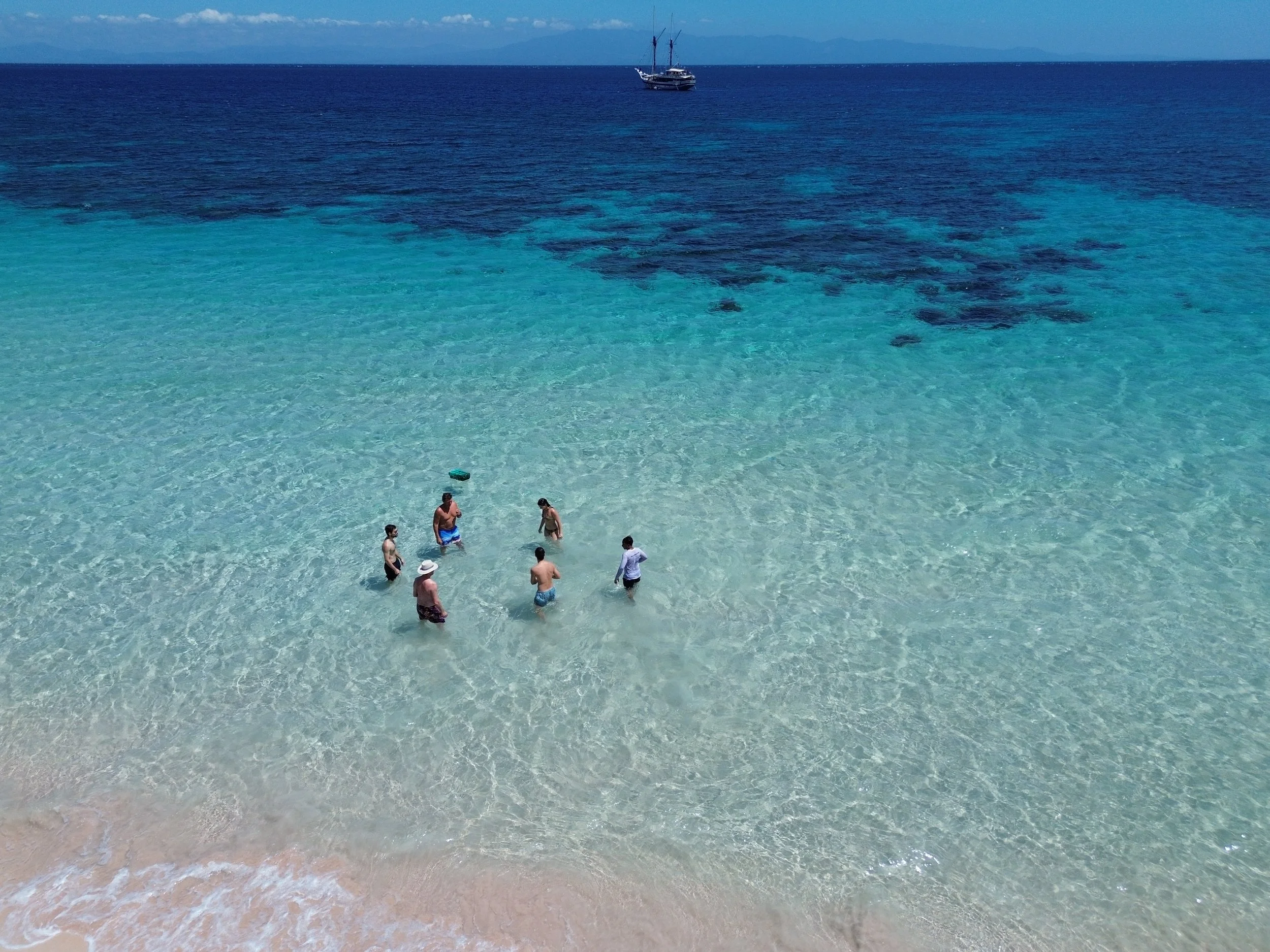My Komodo National Park Core Memories
If you’re picturing a slow, sleepy Komodo dragon lounging on a rock while a group of tourists snaps photos from a safe distance, you’re… partially right. But also very, very wrong.
Welcome to Komodo National Park, a UNESCO World Heritage Site where the world’s last real-life dragons roam free, the sea is a technicolor dream of coral and marine life, and you’ll be sweating buckets from both the heat and the adrenaline.
I’ve been to Komodo National Park more times than I can count, but every visit still makes me feel like I’m stepping into a nature documentary, except this one includes sunscreen, questionable tan lines, and a healthy dose of panic when a 3-meter-long dragon makes direct eye contact.
This is my unfiltered, unboring, and occasionally unhinged guide to one of Indonesia’s wildest destinations.
What and Where is Komodo National Park?
Let’s start with the basics. Komodo National Park is located in the East Nusa Tenggara province of Indonesia, nestled between the islands of Sumbawa and Flores. It covers 29 islands, with Komodo Island, Rinca Island, and Padar Island being the most popular among visitors.
But it’s not all about the dragons. The park is also home to over 1,000 species of fish, 260 species of coral, and enough marine biodiversity to make even David Attenborough giddy.
Still, let’s not kid ourselves: everyone’s here for the dragons.
What Are Komodo Dragons, Really?
Komodo dragons are the largest living lizards on Earth, growing up to 3 meters (10 feet) long and weighing over 70 kilograms (150 lbs). They’ve been around for millions of years, and quite frankly, they act like it. They strut like they own the place which, let’s be honest, they kinda do.
They're also apex predators, meaning they’re at the top of the food chain. They eat deer, wild boars, buffalo, and occasionally each other (no judgment).
For a long time, scientists believed their saliva was loaded with deadly bacteria that helped kill their prey. But more recent research has shown that Komodo dragons actually have venom glands in their mouths. This venom lowers blood pressure, causes massive bleeding, and sends prey into shock, not exactly your average dental routine.
Oh, and did I mention they can run up to 20 km/h? That’s faster than me. And probably you, too.
That One Time I Almost Stepped on One
You’d think after seeing so many Komodo dragons I’d have developed better peripheral vision.
But no.
On one of my earlier visits, while trekking on Rinca Island, I very nearly stepped on a Komodo dragon because I thought it was a log. A log.
I was mid-sentence, chatting away, not paying attention, when our ranger shouted at me to stop.
I froze just in time to realize I was one foot away from a "log" with scales and a pulse.
The dragon barely flinched, just opened one eye as if to say, “Really?”
Lesson learned: logs don't breathe. Always look twice.
Komodo Island vs. Rinca Island: My Hot Take
If you’re deciding between Komodo Island and Rinca Island for your dragon-spotting adventure, allow me to nudge you toward Rinca. In my experience, the trekking is more immersive, the views are stunning, and the dragons feel more… wild.
Komodo Island, while iconic, has started to feel a bit too commercialized for my taste. There’s a big concrete jetty, souvenir stalls everywhere, and sometimes the experience feels a little staged. I’ve had to wait a long time for a ranger to become available, and not all of them follow proper SOP, some just phone it in.
On Rinca, things feel raw and real. The rangers are often more enthusiastic (and more alert, thankfully), and you’re more likely to spot dragons in their natural habitat without a crowd of tourists with selfie sticks crowding the view.
How to Visit Komodo National Park (Without Getting Eaten)
Getting There
The gateway to Komodo National Park is Labuan Bajo, a small fishing town on the western tip of Flores Island. You can fly in from Bali in under 90 minutes.
From Labuan Bajo, you can hop on a phinisi (traditional wooden boat), speedboat, or fancy liveaboard depending on your budget and comfort level.
Choosing the Right Tour
You’ll find options for:
Day trips (great if you’re short on time)
2D1N or 3D2N boat tours (ideal for sunset views and sunrise hikes)
Luxury liveaboards (if you want to scuba dive, drink wine, and pretend you're on Below Deck)
Popular stops include:
Komodo Island (dragons!)
Rinca Island (also dragons, fewer crowds)
Padar Island (Instagram’s favorite view)
Pink Beach (it’s not a filter, it’s real)
Manta Point (snorkel with gentle giants)
Taka Makassar, Siaba, and other underwater gems
Padar Island: Sunrise Hike Goals
If you’ve seen that iconic photo of jagged hills rising from the ocean with three crescent-shaped beaches below, yep, that’s Padar Island.
It’s a steep but manageable hike, best done before sunrise. The view is worth the 4:30 a.m. wake-up call, trust me. Also, fewer people, fewer photo-bombers, and slightly less sweat.
Bring water, wear actual shoes (not flip-flops), and don’t underestimate the stairs. Your quads will remember this hike for days.
Pink Beach: Yes, It's Actually Pink
Thanks to foraminifera, tiny red organisms that mix with the white sand, the beach takes on a soft pink hue. It’s one of only a handful of pink beaches in the world.
Great for:
Snorkeling right off the beach
Floating and pretending you’re in a perfume ad
Taking “candid” Instagram photos that took 34 tries
Komodo Underwater Wonderland
I’ve dived in Thailand, swam with turtles in the Philippines, none of it ruined me quite like Komodo.
Best Snorkeling Spots:
Manta Point (self-explanatory)
Taka Makassar (a dreamy sandbank)
Siaba Besar (aka “turtle city”)
Batu Bolong (stunning coral garden with insane fish traffic)
Pro Tips:
The currents here are no joke. Go with experienced guides.
Don’t touch anything. Not the coral, not the mantas, not even your friend’s foot under water.
Bring reef-safe sunscreen. The ocean will thank you.
Wildlife Watch: More Than Just Dragons
Aside from Komodo dragons, the park is home to:
Timor deer (dragon snacks)
Wild boars (also dragon snacks)
Sea eagles, frigatebirds, and other birds I can’t pronounce
Manta rays, reef sharks, dolphins, and even whale sharks in season
Basically, if you're into wildlife, this is your Disneyland. Except the mascots here might actually kill you.
Responsible Travel Tips
Please don’t be that tourist.
Keep your distance from the dragons. This isn’t a zoo.
Don’t fly drones without permission. The noise stresses out both animals and humans.
Pack out your trash, especially plastic.
Say no to single-use water bottles—refill from your boat.
Support local guides and boat crews. A little generosity goes a long way.
The Best Time to Visit Komodo National Park
Dry season (April–November) is ideal. You’ll get:
Sunny skies
Calm(ish) seas
Great diving conditions
Dragons doing dragon things
Avoid January–February if you can, rough seas and moody weather aren’t great for boat travel or beachy vibes.
If you want to see baby Komodo dragons, aim for March–May. But remember, they mostly hang out in trees to avoid getting eaten by their own kind. Same.
What to Pack for Komodo National Park
Reef-safe sunscreen
Hat + sunglasses
Sturdy shoes (for hikes and dragon dodging)
Swimwear (duh)
Dry bag (for your phone/camera)
Power bank
Motion sickness pills (just in case)
And most importantly: a sense of humor and adventure. Things won’t always go as planned, but that’s part of the charm.
Komodo National Park is Wild—In Every Sense
If you're looking for a buttoned-up, polished vacation with luxury spas and artisanal coffee shops on every corner... maybe sit this one out.
But if you're into raw, untamed nature, ancient predators, some of the best marine life on Earth, and stories you’ll tell for years? Book the ticket. Get on the boat. Go.
Just remember: don’t run. The dragons will outrun you. And the ranger’s stick? It’s more for morale than actual protection.
Thank you for reading and now back to happily roaming!


